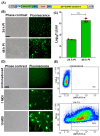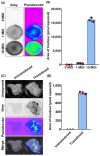A Simple and Versatile Method for Ex Vivo Monitoring of Goat Vaginal Mucosa Transduction by Viral Vector Vaccines
- PMID: 39203977
- PMCID: PMC11359855
- DOI: 10.3390/vaccines12080851
A Simple and Versatile Method for Ex Vivo Monitoring of Goat Vaginal Mucosa Transduction by Viral Vector Vaccines
Abstract
Goat may represent a valid large animal model for human pathogens and new vaccines testing. Appropriate vaccine administration is a critical component of a successful immunization program. The wrong route of administration may reduce the efficacy of the vaccine, whereas the proper administration strategy can enhance it. Viral vectors have been employed successfully for goat and sheep immunization; however, no data concerning the vaginal route are available. A viral vector's ability to transduce the site of inoculation is of primary interest. In this study, a fast and reliable ex vivo assay for testing the transduction capability of an Ad5-based vector when intravaginally administered was developed. An Ad5 vector delivering an expression cassette with a bicistronic reporter gene, Ad5-CMV-turboGFP-IRES-Luc2, was constructed. We demonstrated Ad5-CMV-turboGFP-IRES-Luc2's ability to transduce caprine vaginal mucosa by ex vivo bioluminescent imaging (BLI) employing a simple CCD camera apparatus for chemiluminescence western immunoblotting. These data, though simple, provide valuable insights into developing a vaginal immunization strategy using a viral vector-based vaccine to protect against pathogens causing genital diseases.
Keywords: animal model; bioluminescent imaging; genital diseases; goat; vaginal mucosa vaccines; viral vectors.
Conflict of interest statement
The authors declare no conflicts of interest.
Figures


Similar articles
-
Long term expression of bicistronic vector driven by the FGF-1 IRES in mouse muscle.BMC Biotechnol. 2007 Oct 28;7:74. doi: 10.1186/1472-6750-7-74. BMC Biotechnol. 2007. PMID: 17963525 Free PMC article.
-
Combinatorial Viral Vector-Based and Live Attenuated Vaccines without an Adjuvant to Generate Broader Immune Responses to Effectively Combat Pneumonic Plague.mBio. 2021 Dec 21;12(6):e0322321. doi: 10.1128/mBio.03223-21. Epub 2021 Dec 7. mBio. 2021. PMID: 34872353 Free PMC article.
-
CD46-mediated transduction of a species D adenovirus vaccine improves mucosal vaccine efficacy.Hum Gene Ther. 2014 Apr;25(4):364-74. doi: 10.1089/hum.2013.215. Epub 2014 Apr 10. Hum Gene Ther. 2014. PMID: 24635714 Free PMC article.
-
Vaginal immunization with recombinant gram-positive bacteria.Am J Reprod Immunol. 1998 Mar;39(3):199-208. doi: 10.1111/j.1600-0897.1998.tb00354.x. Am J Reprod Immunol. 1998. PMID: 9526609 Review.
-
Promising Cytomegalovirus-Based Vaccine Vector Induces Robust CD8+ T-Cell Response.Int J Mol Sci. 2019 Sep 10;20(18):4457. doi: 10.3390/ijms20184457. Int J Mol Sci. 2019. PMID: 31510028 Free PMC article. Review.
Cited by
-
In Vitro Antiviral Activity of the Fungal Metabolite 6-Pentyl-α-Pyrone Against Bovine Coronavirus: A Translational Study to SARS-CoV-2.Vet Sci. 2025 Jul 2;12(7):634. doi: 10.3390/vetsci12070634. Vet Sci. 2025. PMID: 40711294 Free PMC article.
References
-
- Gupta S., Janani R., Bin Q., Luciw P., Greer C., Perri S., Legg H., Donnelly J., Barnett S., O’Hagan D., et al. Characterization of Human Immunodeficiency Virus Gag-Specific Gamma Interferon-Expressing Cells following Protective Mucosal Immunization with Alphavirus Replicon Particles. J. Virol. 2005;79:7135–7145. doi: 10.1128/JVI.79.11.7135-7145.2005. - DOI - PMC - PubMed
-
- Gordon S.N., Kines R.C., Kutsyna G., Ma Z.M., Hryniewicz A., Roberts J.N., Fenizia C., Hidajat R., Brocca-Cofano E., Cuburu N., et al. Targeting the Vaginal Mucosa with Human Papillomavirus Pseudovirion Vaccines Delivering Simian Immunodeficiency Virus DNA. J. Immunol. 2012;188:714–723. doi: 10.4049/jimmunol.1101404. - DOI - PMC - PubMed
-
- Weaver E.A., Nehete P.N., Nehete B.P., Yang G., Buchl S.J., Hanley P.W., Palmer D., Montefiori D.C., Ferrari G., Ng P., et al. Comparison of Systemic and Mucosal Immunization with Helper-Dependent Adenoviruses for Vaccination against Mucosal Challenge with SHIV. PLoS ONE. 2013;8:e67574. doi: 10.1371/journal.pone.0067574. - DOI - PMC - PubMed
LinkOut - more resources
Full Text Sources

